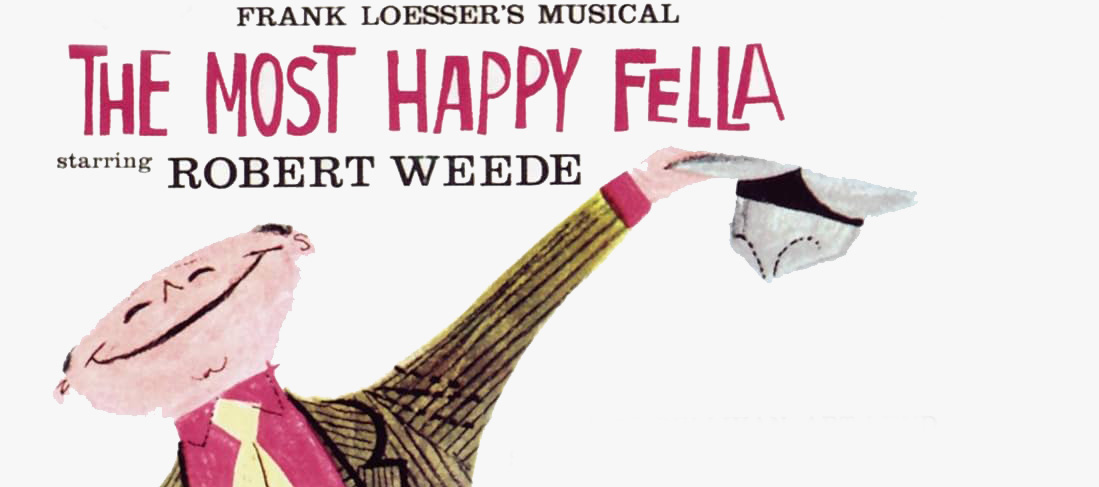Pas de biographie disponible.
Compositeur Musique additionelle Librettiste Parolier Metteur en scène Chorégraphe Producteur création Producteur version
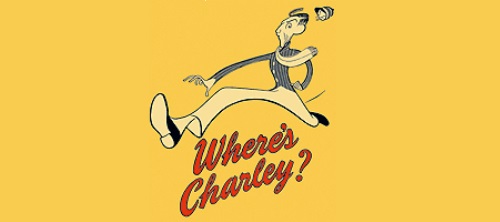
Musical
Musique: Frank Loesser • Paroles: Frank Loesser • Livret: George Abbott • Production originale: 3 versions mentionnées
Dispo: Synopsis Génèse Liste chansons
Genèse: Broadway (1948 and 1951) The musical opened on Broadway at the St. James Theatre on October 11, 1948 and ran for 792 performances. It was directed by George Abbott, choreographed by George Balanchine, with sets and costumes by David Ffolkes. The cast featured Ray Bolger as Charley Wykeham, Allyn McLerie as Amy Spettigue, Byron Palmer as Jack Chesney, Doretta Morrow as Kitty Verdun, Paul England as Sir Francis Chesney, and Horace Cooper as Mr Spettigue. Bolger won the Tony Award, Best Actor (Musical). His second-act song, "Once in Love with Amy", was a show-stopper, with audiences not only demanding that he sing it again, but even singing along. The musical returned to Broadway at The Broadway Theatre for 48 performances, from January 29, 1951 to March 10, 1951, with Bolger, McLerie, and Cooper reprising their roles and Abbott directing. West End (1958) After a trial run at the Opera House in Manchester, the musical opened in the West End at the Palace Theatre on February 20, 1958 and ran for 404 performances. It was directed by William Chappell. The cast featured Norman Wisdom as Charley Wykeham, Pip Hinton as Amy Spettigue, Terence Cooper as Jack Chesney, Pamela Gale as Kitty Verdun, Jerry Desmonde as Sir Francis Chesney, and Felix Felton as Mr Spettigue. Circle in the Square Broadway Revival Circle in the Square produced a revival starring Raul Julia as part of its 1974-75 Broadway season. Julia received a Tony Award nomination for his performance. Encores! (2011) A semi-staged production of Where's Charley? was presented as part of New York City Center's Encores! series from March 17–20, 2011, featuring Rebecca Luker and Howard McGillin, and Rob McClure as Charley.
Résumé:
Création: 11/10/1948 - St. James Theatre (Broadway) - représ.
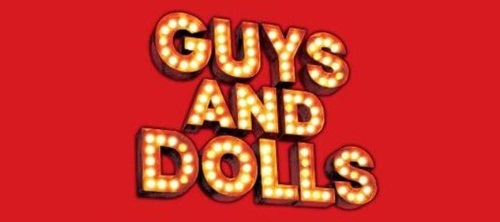
Musical
Musique: Frank Loesser • Paroles: Frank Loesser • Livret: Abe Burrows • Jo Swerling • Production originale: 16 versions mentionnées
Dispo: Résumé Synopsis Génèse Isnpiration Liste chansons
Vidéos:
Genèse: Background Guys and Dolls was conceived by producers Cy Feuer and Ernest Martin as an adaptation of Damon Runyon's short stories. These stories, written in the 1920s and 1930s, concerned gangsters, gamblers, and other characters of the New York underworld. Runyon was known for the unique dialect he employed in his stories, mixing highly formal language and slang. Frank Loesser, who had spent most of his career as a lyricist for movie musicals, was hired as composer and lyricist. George S. Kaufman was hired as director. When the first version of the show's book, written by Jo Swerling, was deemed unusable, Feuer and Martin asked radio comedy writer Abe Burrows to write a new version of the book. Loesser had already written much of the score to correspond with the first version of the book. Burrows later recalled, "Frank Loesser's fourteen songs were all great, and the [new book] had to be written so that the story would lead into each of them. Later on, the critics spoke of the show as 'integrated'. The word integration usually means that the composer has written songs that follow the story line gracefully, Well, we accomplished that but we did it in reverse". The character of Miss Adelaide was created specifically to fit Vivian Blaine into the musical, after Loesser decided she was ill-suited to play the conservative Sarah.[8] When Loesser suggested reprising some songs in the second act, Kaufman warned: "If you reprise the songs, we’ll reprise the jokes." Original productions The musical premiered on Broadway at the 46th Street Theatre on November 24, 1950. It was directed by George S. Kaufman, with dances and musical numbers by Michael Kidd, scenic and lighting design by Jo Mielziner, costumes by Alvin Colt, and orchestrations by George Bassman and Ted Royal, with vocal arrangements by Herbert Greene. It starred Robert Alda, Sam Levene, Isabel Bigley, and Vivian Blaine. Iva Withers was a replacement as Adelaide. The musical ran for 1.200 performances, winning five 1951 Tony Awards, including the award for Best Musical. Decca Records issued the original cast recording on 78 rpm records, which was later expanded and re-issued on LP, and then transferred to CD in the 1980s. The West End premiere opened at the London Coliseum on May 28, 1953 and ran for 555 performances. The cast starred Vivian Blaine, Sam Levene, Lizbeth Webb and Jerry Wayne. Lizbeth Webb was the only major principal who was British and was chosen to play the part of Sarah Brown by Frank Loesser. The show has had numerous revivals and tours and has become a popular choice for school and community theatre productions. New York City Center 1955, 1965 and 1966 revivals New York City Center mounted short runs of the musical in 1955, 1965 and 1966. A production starring Walter Matthau as Nathan Detroit, Helen Gallagher as Adelaide, Ray Shaw as Sky and Leila Martin as Sarah had 31 performances, running from April 20 to May 1, and May 31 to June 12, 1955. Another presentation at City Center, with Alan King as Nathan Detroit, Sheila MacRae as Adelaide, Jerry Orbach as Sky and Anita Gillette as Sarah, ran for 15 performances from April 28 to May 9, 1965. A 1966 production, starring Jan Murray as Nathan Detroit, Vivian Blaine reprising her role as Adelaide, Hugh O'Brian as Sky, and Barbara Meister as Sarah, ran for 23 performances, from June 8 to June 26, 1966. 1976 Broadway revival Libretto and vocal book, Music Theatre International (1978), rented out to actors.An all-black cast staged the first Broadway revival of the show, which opened on July 11, 1976 in previews, officially on July 21, at The Broadway Theatre. It starred Robert Guillaume as Nathan Detroit, Norma Donaldson as Miss Adelaide, James Randolph as Sky and Ernestine Jackson as Sarah Brown. Guillaume and Jackson were nominated for Tony and Drama Desk Awards, and Ken Page as Nicely-Nicely won a Theatre World Award. This production featured Motown-style musical arrangements by Danny Holgate and Horace Ott, and it was directed and choreographed by Billy Wilson. The entire production was under the supervision of Abe Burrows, and musical direction and choral arrangements were by Howard Roberts. The show closed on February 13, 1977 after 239 performances and 12 previews. A cast recording was released subsequent to the show's opening. 1982 London revival Laurence Olivier had wanted to play Nathan Detroit, and began rehearsals for a planned 1971 London revival of Guys and Dolls at his National Theatre Company's Old Vic theatre. However, due to poor health he had to stop, and his revival never saw the light of day. In 1982, Richard Eyre directed a major revival at London's National Theatre. Eyre called it a "re-thinking" of the musical, and his production featured an award-winning neon-lit set design inspired by Rudi Stern's 1979 book Let There Be Neon, and brassier orchestrations with vintage yet innovative harmonies. The show's choreography by David Toguri included a large-scale tap dance number of the "Guys and Dolls" finale, performed by the principals and entire cast. The revival opened March 9, 1982, and was an overnight sensation, running for nearly four years and breaking all box office records. The original cast featured Bob Hoskins as Nathan Detroit, Julia McKenzie as Adelaide, Ian Charleson as Sky and Julie Covington as Sarah. The production won five Olivier Awards, including for McKenzie and Eyre and for Best Musical. Eyre also won the Evening Standard Award, and Hoskins won the Critics' Circle Theatre Award. In October 1982, Hoskins was replaced by Trevor Peacock, Charleson by Paul Jones, and Covington by Belinda Sinclair; in the spring of 1983 McKenzie was replaced by Imelda Staunton and Fiona Hendley replaced Sinclair. This production closed in late 1983 to make way for a Broadway try-out of the ill-fated musical Jean Seberg, which following critical failure closed after four months. Eyre's Guys and Dolls returned to the National from April through September 1984, this time starring Lulu, Norman Rossington, Clarke Peters and Betsy Brantley. After a nationwide tour, this production transferred to the West End at the Prince of Wales Theatre, where it ran from June 1985 to April 1986. Following Ian Charleson's untimely death from AIDS at the age of 40, in November 1990 two reunion performances of Guys and Dolls, with almost all of the original 1982 cast and musicians, were given at the National Theatre as a tribute to Charleson. The tickets sold out immediately, and the dress rehearsal was also packed. The proceeds from the performances were donated to the new Ian Charleson Day Centre HIV clinic at the Royal Free Hospital, and to scholarships in Charleson's name at LAMDA. 1992 Broadway revival DVD cover of the 1992 cast-album recording documentary, Guys and Dolls: Off the Record, starring Peter Gallagher, Josie de Guzman, Nathan Lane, and Faith PrinceThe 1992 Broadway revival was the most successful American remounting of the show since its original opening. Directed by Jerry Zaks, it starred Nathan Lane as Nathan Detroit, Peter Gallagher as Sky, Faith Prince as Adelaide and Josie de Guzman as Sarah. This production played at the Martin Beck Theatre from April 14, 1992 to January 8, 1995, with 1,143 performances. The production received a rave review from Frank Rich in The New York Times, stating "It's hard to know which genius, and I do mean genius, to celebrate first while cheering the entertainment at the Martin Beck." It received eight Tony Award nominations, and won four, including Best Revival of a Musical, and the show also won the Drama Desk Award for Outstanding Revival. This revival featured various revisions to the show's score, including brand new music for the "Runyonland", "A Bushel and a Peck," "Take Back Your Mink" and "Havana". The orchestrations were redesigned by Michael Starobin, and there were new dance arrangements added to "A Bushel and a Peck" and "Take Back Your Mink". A one-hour documentary film captured the recording sessions of the production's original cast album. Titled Guys and Dolls: Off the Record, the film aired on PBS's Great Performances series in December 1992, and was released on DVD in 2007. Complete takes of most of the show's songs are featured, as well as coaching from director Zaks, and commentary sessions by stars Gallagher, de Guzman, Lane, and Prince on the production and their characters. 1996 London revival Richard Eyre repeated his 1982 success with another National Theatre revival of the show, this time in a limited run. It starred Henry Goodman as Nathan Detroit, Imelda Staunton returning as Adelaide, Clarke Peters returning as Sky and Joanna Riding as Sarah. Clive Rowe played Nicely-Nicely Johnson, and David Toguri returned as choreographer. The production ran from December 17, 1996 through March 29, 1997 and from July 2, 1997 to 22 November 22, 1997.[33][34] It received three Olivier Award nominations, winning one: Best Supporting Performance in a Musical went to Clive Rowe. Richard Eyre won the Critics' Circle Theatre Award for Best Director, and the production won Best Musical. 2005 West End revival The 2005 West End revival opened at London's Piccadilly Theatre in June 2005 and closed in April 2007. This revival, directed by Michael Grandage, starred Ewan McGregor as Sky, Jenna Russell as Sarah, Jane Krakowski as Adelaide, and Douglas Hodge as Nathan Detroit. During the run, Nigel Harman, Adam Cooper, Norman Bowman and Ben Freeman took over as Sky; Kelly Price, Amy Nuttall and Lisa Stokke took over as Sarah; Sarah Lancashire, Sally Ann Triplett, Claire Sweeney and Samantha Janus took over as Adelaide; and Nigel Lindsay, Neil Morrissey, Patrick Swayze, Alex Ferns and Don Johnson took over as Nathan Detroit. This production added the song "Adelaide" that Frank Loesser had written for the 1955 film adaptation. According to a September 2007 article in Playbill.com, this West End production had been scheduled to begin previews for a transfer to Broadway in February 2008, but this plan was dropped. 2009 Broadway revival A 2009 Broadway revival of the show opened on March 1, 2009 at the Nederlander Theatre. The cast starred Oliver Platt as Nathan Detroit, Lauren Graham, in her Broadway debut, as Adelaide, Craig Bierko as Sky and Kate Jennings Grant as Sarah. Des McAnuff was the director, and the choreographer was Sergio Trujillo. The show opened to generally negative reviews. The New York Times called it "static" and "uninspired", the New York Post said, "How can something so zippy be so tedious?" and Time Out New York wrote, "Few things are more enervating than watching good material deflate." However, the show received a highly favorable review from The New Yorker, and the producers decided to keep the show open in hopes of positive audience response. The New York Post reported on March 4 that producer Howard Panter "[said] he'll give Guys and Dolls at least seven weeks to find an audience." The revival closed on June 14, 2009 after 28 previews and 113 performances.
Résumé: Desperate to find money to pay for his floating crap game, Nathan Detroit bets Sky Masterson a thousand dollars that Sky will not be able to take a local Salvation Army girl, Sarah Brown, to Cuba. While Sky eventually is able to convince Sarah to join him, Nathan battles with his fiancé of fourteen years, Adelaide. Meanwhile in Cuba, Sky ends up falling in love with Sarah and tries to reform his gambling ways. When he returns back to New York, he bets all the members of the floating crap game that if he wins his roll of the dice, they will all have to go to church and repent. If he loses, he will give them each a thousand dollars. He ends up winning and all the gamblers end up visiting the mission and repenting their sins. Dancing in this show requires jazz and showdance. Read more: http://www.stageagent.com/Shows/View/711#ixzz2UKNtjUZ2
Création: 24/11/1950 - Richard Rodgers Theatre (Broadway) - représ.
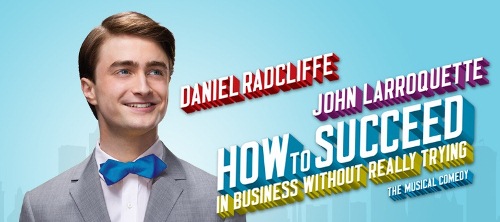
Musical
Musique: Frank Loesser • Paroles: Frank Loesser • Livret: Abe Burrows • Production originale: 8 versions mentionnées
Dispo: Résumé Synopsis Génèse Liste chansons
Genèse: In 1952, Shepherd Mead's satirical book, How to Succeed in Business Without Really Trying, became a bestseller. Playwright Willie Gilbert and fellow playwright Jack Weinstock created a dramatic interpretation in 1955 that was unproduced for five years. Agent Abe Newborn brought the work to the attention of producers Cy Feuer and Ernest Martin, with the intention of retooling it as a musical. Feuer and Martin had great success with the 1950 adaptation of Guys and Dolls and brought in the creative team from that show to work on How to.... Abe Burrows and Frank Loesser set to work on the new adaptation, with rehearsals beginning in August 1961. Burrows collaborated on the book with Jack Weinstock and Willie Gilbert, also serving as director. Their new adaptation became even more satirical and added romance to the story. Loesser wrote both music and lyrics for the show, which was orchestrated by Robert Ginzler. The original Broadway production credited the choreography to an obscure dance director named Hugh Lambert, while the much better-known Bob Fosse received only a "musical staging by..." credit. Abe Burrows explains this in his autobiography Honest, Abe. While How to Succeed... was in its early development, producer Cy Feuer attended a trade show and was extremely impressed by an elaborate dance number created by Lambert, prompting Feuer to hire Lambert to choreograph the new musical. According to Burrows, it soon became clear in rehearsals that Lambert's creative abilities were completely used up in that one elaborate dance number. Bob Fosse was brought in to replace him, but Fosse was unwilling to hurt Lambert's career by having him fired. Lambert's trade-show dance number was recycled as the "Treasure Hunt" dance in How to Succeed..., while Fosse agreed to take a "musical staging" credit for choreographing all the other dance numbers. Burrows also reveals that another crisis arose in rehearsals when former recording star Rudy Vallee wanted to interpolate some of his hit songs from the 1930s. Broadway (1961-1965) The show opened on Broadway on October 14, 1961 at the 46th Street Theatre, and closed on March 6, 1965 after 1,417 performances. The cast starred Robert Morse as Finch, Bonnie Scott as his secretary Rosemary, Charles Nelson Reilly as Bud Frump, and Rudy Vallee as the company president. Virginia Martin played Hedy LaRue. West End (1963-1964) The West End production opened at the Shaftesbury Theatre on March 28, 1963 and ran for 520 performances. It was also directed by Burrows and Bob Fosse, and featured a new London cast. Warren Berlinger and Billy De Wolfe starred as Finch and Biggley respectively, with Patricia Michael as Rosemary, Josephine Blake as Smitty, David Knight as Bud Frump, Olive Lucius as Miss Jones, Bernard Spear as Mr. Twimble, and Eileen Gourlay as Hedy La Rue. Broadway revival (1995-1996) A Broadway revival opened at the original theatre, now renamed Richard Rodgers Theatre on March 23, 1995 and closed on July 14, 1996 after 548 performances. It was directed by Des McAnuff and choreographed by Wayne Cilento. Matthew Broderick starred as Finch, and Rosemary was played by Megan Mullally. In a pre-recorded performance, Walter Cronkite was the Book Voice. The replacements for Mullally and Broderick were Broderick's future wife, Sarah Jessica Parker as Rosemary and John Stamos as Finch. The wardrobe was designed by Susan Hilferty and is on display at the Costume World Broadway Collection in Pompano Beach, Florida. US National Tour (1996-1997) A national tour of 'How To Succeed' ran beginning in Baltimore in May 1996 and ended in Milwaukee in June 1997. Other stops included Sacramento, Portland, and Seattle. The national tour cast featured Ralph Macchio as J. Pierrepont Finch, Shauna Hicks (Rosemary Pilkington), Richard Thomsen (J.B. Biggley), Pamela Blair (Hedy LaRue), and Roger Bart (Bud Frump). Both Macchio and the production played to favorable reviews. Broadway revival (2011-2012) Daniel Radcliffe was featured in a reading in December 2009, with Rob Ashford as director and choreographer. Radcliffe starred in the revival for ten months, which began previews at the Al Hirschfeld Theatre on February 26, 2011, with the official opening on March 27, 2011. Rob Ashford directs and choreographs. Other cast includes Rose Hemingway as Rosemary Pilkington, Mary Faber as Smitty, Tammy Blanchard as Hedy La Rue, Christopher Hanke as Bud Frump, and John Larroquette as J.B. Biggley. Anderson Cooper has recorded the Voice of the Book for the adaptation. The production was nominated for nine 2011 Tony Awards, including for director-choreographer Rob Ashford and as Best Revival of a Musical. John Larroquette won the Tony Award for Best Featured Actor in a Musical. Darren Criss succeeded Radcliffe in the role of J. Pierrepont Finch for a limited three week engagement from January 3–22, 2012. Criss was awarded the Broadway.com Audience Choice Award for Favorite Replacement for his performance in this role. Beau Bridges replaced John Larroquette as J.B. Biggley starting January 3, 2012. Nick Jonas took over the role of Finch on January 24, 2012. Jonas was nominated for a 2012 Broadway Beacon Award for his performance in this role. Michael Urie replaced Christopher Hanke in the role of Bud Frump starting on January 24, 2012. The production closed on May 20, 2012 after 30 previews and 473 regular performances.
Résumé: Finch is a window washer who finds a book called "How to Succeed in Business Without Really Trying," which he uses to get a job at World Wide Wickets and move up in the company. Frump, a co-worker he left behind on the way up, tries to sabotage Finch as he gets higher and higher in the organization, but in the end Finch is forced to make a few choices without the help of his book.
Création: 14/10/1961 - Richard Rodgers Theatre (Broadway) - représ.
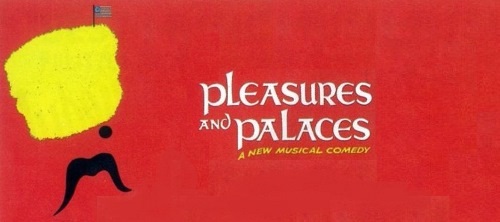
Musical
Musique: Frank Loesser • Paroles: Frank Loesser • Livret: Frank Loesser • Samuel Spewack • Production originale: 1 version mentionnée
Dispo: Résumé Génèse Isnpiration Liste chansons
Genèse: The Broadway-bound production, directed and choreographed by Bob Fosse, opened on March 11, 1965 at the Fisher Theatre in Detroit. The cast included Alfred Marks, Phyllis Newman, and John McMartin. The musical closed out-of-town and was not produced on Broadway.[2] The Detroit Press described it as "lesser Loesser," the Detroit Free Press said of it, "It's a Rolls-Royce of a show, a magnificent combination of artful scenery, lively choreography, and engaging people. But there's no gas in the Rolls-Royce tank," and Variety called it "disappointing." Cy Feuer and Abe Burrows were called in to help with revisions,[3]and Fosse was willing to invest his own money in order to get the production to Boston, but after its closing on April 10, Loesser cancelled the rest of the tryout tour and the New York City opening. The show was revived by the Lyric Stage of Irving, Texas in January 2013.
Résumé: Russia's aging Empress, Catherine the Great, makes a grand tour of the Crimea in 1788 arranged by her uncertain lover, Field Marshal Governor General Potemkin. Catherine engages American Revolutionary War naval hero Captain John Paul Jones to lead the Russian fleet in the Black Sea against the Turks. Aware that Catherine is attracted to Scotsman Jones, jealous Potemkin uses all his intrigue and wiles to discredit the former American hero. Nymphomaniac Sura, one of Potemkin's "nieces," makes her own Russian assault on John Paul Jones, getting him drunk and into her boudoir. But Presbyterian Jones' Calvinistic lecturing dissuades sexpot Sura for a brief reformation. Potemkin's fear of becoming just another of the Empress's discarded lovers is, temporarily, calmed and he is reinstated in Catherine's favor.
Création: 11/3/1965 - * Jamais ouvert () - 0 représ.
